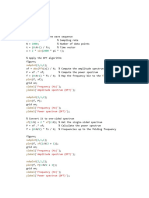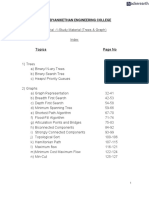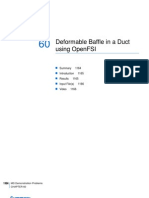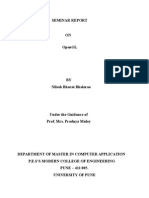Lms Code
Uploaded by
saisreeLms Code
Uploaded by
saisreeclc;
close all;
clear all;
%N=input('length of sequence N = ');
%t=[0:N-1];
%w0=0.001; phi=0.1;
%d=sin(2*pi*[1:N]*w0+phi);
%x=d+randn(1,N)*0.5;
[d fs]=audioread('RecdSpeech.m4a');
N = length(d);
%sound(d,47000);
x = awgn(d,20);%%Speech+Noise = x
%plot(X);
%sound(x,47000);
w=zeros(1,N);
mu=input('mu = ');
tic
for i=1:N
e(i) = d(i) - w(i)' * x(i);
w(i+1) = w(i) + mu * e(i) * x(i);
end
for i=1:N
yd(i) = (sum(w(i)' * x(i)))/10;
end
subplot(221),plot(d),ylabel('Desired Signal'),
subplot(222),plot(x),ylabel('Input Signal+Noise'),
subplot(223),plot(e),ylabel('Error'),
subplot(224),plot(yd),ylabel('Adaptive Desired output');
%sound(x,fs);
%pause(5);
sound(yd,fs);
toc
%%
% *Cross Correlation of Signals*
d = d(:,1);
x = x(:,1);
yd = transpose(yd);
[Rx1, lags1] = xcorr(d,x, 'coeff');
[Rx2, lags2] = xcorr(d,yd, 'coeff');
delay1 = lags1/fs;
delay2 = lags2/fs;
Rx3 = crosscorr(d,x);
Rx4 = crosscorr(d,yd);
delay3 = -20:1:20;
figure(2)
subplot(221),plot(delay1, Rx1, 'r');
grid on
xlim([-max(delay1) max(delay1)]);
set(gca, 'FontName', 'Times New Roman', 'FontSize', 10);
xlabel('Delay'),ylabel('Cross Correlation coefficient'),title('X Corr of the Input
and Noisy Signal');
subplot(223),plot(delay2, Rx2, 'r');
grid on
xlim([-max(delay2) max(delay2)]);
set(gca, 'FontName', 'Times New Roman', 'FontSize', 10);
xlabel('Delay'),ylabel('Cross Correlation coefficient'),title('X corr of Input and
Denoised signal');
subplot(222),plot(delay3,Rx3,'r');
grid on
set(gca, 'FontName', 'Times New Roman', 'FontSize', 10);
xlabel('Delay'),ylabel('Cross Correlation coefficient'),title('X Corr of the Input
and Noisy Signal');
subplot(224),plot(delay3,Rx4,'r');
grid on
set(gca, 'FontName', 'Times New Roman', 'FontSize', 10);
xlabel('Delay'),ylabel('Cross Correlation coefficient'),title('X Corr of the Input
and Denoised Signal');
%%
% *%% CCF Coeff*
cc = corrcoef(d,x);
cross_core = cc(1,2);
fprintf('CC Coeff of Input = %f\n',cross_core);
cc1 = corrcoef(d,yd);
cross_core1 = cc1(1,2);
fprintf('CC Coeff of Output = %f\n',cross_core1);
%%
% *%%Time taken = 2.007945/2.001476 sec*
%% Calculatingg MSE
ESqrAvg = 0;
for i=1:N
ESqrAvg = ESqrAvg + (e(i)*e(i));
end
% MSE = e(N-1)*e(N-1);
MSE = ESqrAvg/N;
fprintf('MSE = %f\n',MSE);
%Last MSE value got = 0.0031
%%
% *%%Mean Absolute Error*
MAE = 0;
for i = 1:N
MAE = MAE + abs(d(i)-yd(i));
end
MAE = MAE/N;
fprintf('MAE = %f\n',MAE);
%%
% *%%Plotting filter coefficient plot*
figure(3)
plot(w);
%% Calculating SNR of Output
% x = transpose(x);
% d = transpose(d);
% SNRydx = snr(yd,x);
% SNRdx = snr(d,x);
% SNRdyd = snr(d,yd);
% SNRydd = snr(yd,d);
% SNRxd = snr(x,d);
% SNRxyd = snr(x,yd);
% SNR1 = snr(x,fs);
% SNR2 = snr(d,fs);
% SNR3 = snr(yd,fs);
% [r1,noisepow1] = snr(x); %r value same as SNR123 values above
% [r2,noisepow2] = snr(d);
% [r3,noisepow3] = snr(yd);
% mxm1 = max(abs(x));
% mxm2 = max(abs(d));
% mxm3 = max(abs(yd));
% SNR1 = (10*log10((mxm1*mxm1)/MSE));
% SNR2 = (10*log10((mxm2*mxm2)/MSE));
% SNR3 = (10*log10((mxm3*mxm3)/MSE));
Num1 = 0; Den1 = 0;
for i = 1:N
Num1 = Num1 + d(i)^2;
end
for i = 1:N
Den1 = Den1 + (x(i)-d(i))^2;
end
SNRIp = 20*log10(sqrt(Num1)/sqrt(Den1));
Num2 = 0; Den2 = 0;
for i = 1:N
Num2 = Num2 + d(i)^2;
end
for i = 1:N
Den2 = Den2 + (yd(i)-d(i))^2;
end
SNROp = 20*log10(sqrt(Num2)/sqrt(Den2));
%%
% *%%Memory Required*
[user,sys] = memory;
a = user.MaxPossibleArrayBytes;
b = user.MemUsedMATLAB;
c = sys.SystemMemory.Available;
d = sys.PhysicalMemory.Available;
e = sys.PhysicalMemory.Total;
f = e-d;
fprintf('Maximum Possible Array Bytes = %.2f MB\n',a/1000000);
fprintf('Memory Used in MATLAB = %.2f MB\n',b/1000000);
fprintf('Available System Memory = %.2f MB\n',c/1000000);
fprintf('Total Physical Memory = %.2f MB\n',e/1000000);
fprintf('Available Physical Memory = %.2f MB\n',d/1000000);
fprintf('Physical Memory used = %.2f MB\n',f/1000000);
You might also like
- CT 303 Digital Communications Lab 9: Heer Gohil 201901135No ratings yetCT 303 Digital Communications Lab 9: Heer Gohil 20190113525 pages
- All All: %two Channel Quadrature Mirror Filter Bank %perfect Reconstruction of InputNo ratings yetAll All: %two Channel Quadrature Mirror Filter Bank %perfect Reconstruction of Input17 pages
- Problem 2.1:: Frequency (HZ) Amplitude Spectrum (DFT)No ratings yetProblem 2.1:: Frequency (HZ) Amplitude Spectrum (DFT)57 pages
- Department of Computer Engineering, University of Engineering & Technology, TaxilaNo ratings yetDepartment of Computer Engineering, University of Engineering & Technology, Taxila9 pages
- Experiment No: 4 Comparison of Diversity Combining Techniques - SC, Egc & MRCNo ratings yetExperiment No: 4 Comparison of Diversity Combining Techniques - SC, Egc & MRC4 pages
- Experiment 1 1. (A) Generation of (I) Delta (T) (Ii) U (T) (Iii) R (T) (Iv) Parabolic Function (V) Signum Function (Vi) Sinc FunctionNo ratings yetExperiment 1 1. (A) Generation of (I) Delta (T) (Ii) U (T) (Iii) R (T) (Iv) Parabolic Function (V) Signum Function (Vi) Sinc Function31 pages
- MATLAB Source Codes Otsu Thresholding Method: All 'Angiogram1 - Gray - JPG'No ratings yetMATLAB Source Codes Otsu Thresholding Method: All 'Angiogram1 - Gray - JPG'10 pages
- %1 Dimensional Array Statistical Measure: All AllNo ratings yet%1 Dimensional Array Statistical Measure: All All23 pages
- Reverse Time Migration (RTM) using finite difference methodNo ratings yetReverse Time Migration (RTM) using finite difference method2 pages
- Part-A Experiments Using Matlab: DSP Lab ManualNo ratings yetPart-A Experiments Using Matlab: DSP Lab Manual40 pages
- Akustik Air: KL3104 Task 0 Irsan Soemantri B., PH.DNo ratings yetAkustik Air: KL3104 Task 0 Irsan Soemantri B., PH.D5 pages
- ADD - D - 04 - Raulia Reno Cahyaningtyas - 03411640000063No ratings yetADD - D - 04 - Raulia Reno Cahyaningtyas - 034116400000636 pages
- Matlab: 'HZ Sine Wave To 20Hz Square Wave ConversionNo ratings yetMatlab: 'HZ Sine Wave To 20Hz Square Wave Conversion10 pages
- Week4: 1. Consider The Two LTI System Connected As Shown BelowNo ratings yetWeek4: 1. Consider The Two LTI System Connected As Shown Below6 pages
- YT-96H-O3 ONLINE GAS DETECTOR - SafegasNo ratings yetYT-96H-O3 ONLINE GAS DETECTOR - Safegas11 pages
- Deformable Baffle in A Duct Using OpenFSINo ratings yetDeformable Baffle in A Duct Using OpenFSI4 pages
- LearnEnglish Listening B2 A Design Presentation PDFNo ratings yetLearnEnglish Listening B2 A Design Presentation PDF4 pages
- Comparative Safety Analysis of LNG Storage Tanks PDFNo ratings yetComparative Safety Analysis of LNG Storage Tanks PDF247 pages
- Examen Anglais Lettres 2018 Session Normale CorrigeNo ratings yetExamen Anglais Lettres 2018 Session Normale Corrige1 page































































































